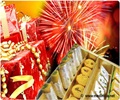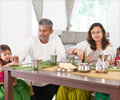Diwali is the festival of lights celebrated by Hindus with great fanfare all over the world. But, it is in India that one should be during this festival to experience the joie de vivre of it all.
For many, it is a time of expressing their love and friendship by exchanging gifts and greetings or simply traveling (even across continents) to spend time with their loved ones. To us though, the festival takes on a different light. Setting aside the why and how of the celebrations, we will contend ourselves mainly to its effects.As sure as Diwali is a festival of gaiety, splendor, fire works, prayers and feasting, it is also one of deafening noise, blinding light, risky fire and suspended particles. And that means direct effects on our health and environment.
Smoking Out Facts
Fire works and crackers - these are the ‘reflectors’ of the spirit of Diwali. To many children (and some adults), the festival is all about how many crackers they burst or what’s the newest, loudest and longest fire -cracker on the shelf! Alas! Little thought is given to the hazards these can cause.
The ‘sparkle, smoke and sound’ package of Diwali treats you to toxic chemicals, suspended particles and high noise levels. Chemicals spewed into the environment range from heavy metals like cadmium and lead to others like copper, manganese, zinc, sodium, magnesium and potassium. The suspended particles hang like a thick blanket reducing visibility and suffocating the atmosphere. Noise levels cross the threshold of human tolerance.
Firecrackers are ‘power packed’ with 75 % potassium nitrate, 15% carbon and 10 % sulphur. When ignited, they burst, allowing these powerful chemicals to come in contact with atmospheric oxygen. The combination generates noxious oxides of carbon, sulphur and nitrogen. Studies have revealed that during Diwali, the levels of these gases rise more than 100%. A Toxic Links study also points out that there exists a threat of exposure to chemicals from unburnt firecrackers too.
Fire is always a looming risk during Diwali. Fire accidents and Diwali go hand in hand. Each year there are many reports of burns and burning. What starts out as an evening of fun can quickly turn into a nightmare due to sheer carelessness and negligence.
Noise and Diwali are inseparable allies. Our ears can tolerate sound up to 60 dB; for each increase thereof by 10 dB, the volume and intensity of sound is doubled. When sound becomes intolerable and unwanted, it qualifies as ‘noise’. And Diwali is certainly a noisy affair! The high noise levels during Diwali can affect our auditory organs and also contribute to other ill health effects. In India, though the Delhi Pollution Control Committee has issued an ordinance stating that a cracker must be set off at a distance of 4 meters and its noise should not exceed 125 decibels, it is gaily flouted every Diwali. So too is the Supreme Courts’ order issued in 2000 that bans the lighting of firecrackers between 10pm and 6am during Diwali celebrations.
One is exposed to two kinds of noise on this day- (1) sudden noise caused by a cracker bursting close-by and (2) continuous noise of crackers and fire works throughout the festivities. Either of these could result in temporary deafness, which thankfully is reversible! More alarming is the case when a loud noise results in perforation or damage to the ear tissue. If this is extensive, then permanent hearing loss can occur. Other distressing health effects can be fatigue, over- reaction, headaches, irritability, hypertension, disturbed sleep and even heart attacks.
Populations most susceptible to noise induced health conditions are-
• Infants below one-year who have very delicate ear structures
• Senior citizens already afflicted with degenerative conditions
• People with heart conditions or hyper/hypotension
• Children and pregnant women
Throwing Light On Solutions
Without dampening the spirit of Diwali, let’s enumerate on possible means of celebrating it in a ‘healthy’ manner.
‘To protect oneself and the environment’ must be the motto on Diwali, each year. This means making sure that -
• We use only legal firecrackers
• Fireworks are lighted only in open spaces
• Only close fitting and cotton or ‘khadi’ clothes are worn, especially when lighting crackers
• A safe distance is maintained while igniting crackers
• Adults constantly monitor young children
• A tub of water is always handy in the event of a fire accident; if burns do occur, run cold water over the affected part and consult a doctor immediately
• More noiseless crackers are set off, which can give as much pleasure as noisy ones with the added advantage of retaining our powers of hearing intact!
• No firecrackers are burst close to hospitals or other ‘silence zones’
• We find more eco-friendly and humane ways of celebrating Diwali; setting the trend are the children of NCL School, Pune who celebrate Diwali differently. They share clothes with needy children. Also, many children today are aware that to a large extent, it is their lesser privileged brothers and sisters who make firecrackers under the most wretched factory conditions; so they refuse to buy crackers!
When young minds can fill with such compassionate thoughts and find alternative means to celebrate Diwali, isn’t it time that others too pitch in?
Diwali is a joyous occasion-what better way to find that joy as we celebrate the festival of lights in a new and different light?
Source-Medindia
ASH/C











